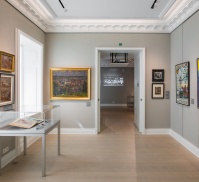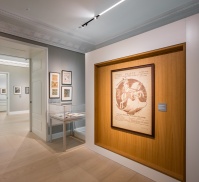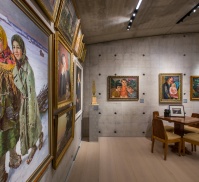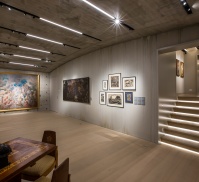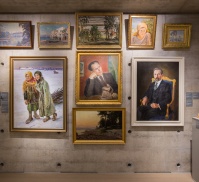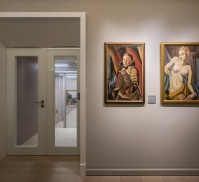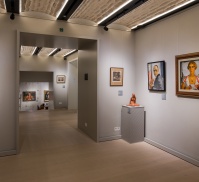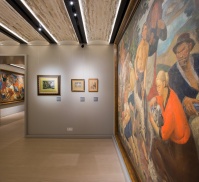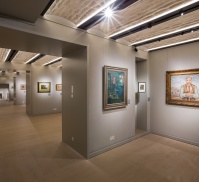1918–1945 / Kaunas–Vilnius
In its third exhibition, the Lithuanian Art Centre Tartle presents an exceptional part of its collection, offering a broad look at artistic life in Kaunas and Vilnius during the interwar period and the Second World War. The interwar period attracts much attention from cultural historians and art historians, and it also continues to attract popular attention. The public interest and the willingness to develop a deeper appreciation of the cultural and historical contexts of those years help to foster a sense of pride in the state, as well as enlightening the viewer. However, most exhibitions on this theme do not present Lithuanian art and Polish art from the firsthalf of the 20th century together. They often fail to include artistic reflections on the situation in Vilnius, the former capital of the Grand Duchy of Lithuania: this limits the opportunities to compare the situations in Kaunas and Vilnius, both of which were important artistic centres, and to discuss differences in trends in artistic expression and cultural life.
This exhibition presents well-established figures in the visual arts of Lithuania and Poland, such as Adomas Galdikas, Antanas Gudaitis, Jerzy Hoppen, Bronisław Jamontt, Juozas Mikėnas, Tymon Niesiołowski, Petras Rimša, Antanas Samuolis, Ludomir Sleńdziński, Stasys Ušinskas, Justinas Vienožinskis and Antanas Žmuidzinavičius. Paintings, sculptures, prints, drawings, photographs and publications from the Tartle collection are displayed, providing a multifaceted presentation of the cultural and social contexts of those extremely complex years.
The ground floor of the gallery is devoted to portrayals of the two cities, the phenomena of the capital and the former capital, immortalised in works by artists and photographers. Whereas the image of Kaunas appears to have been shaped by Lithuanian artists who were anchored in national feeling and the spirit of modernity, the image of Vilnius that was developed by local artists emphasised tradition and romantic inspiration from the past. A common historical narrative is evoked, along with an interpretation of it in Lithuanian and Polish public life and art. The Vilnius question, which still occasionally flares up, is not swept under the carpet, either: it is represented by both serious and ironic images from propaganda art.
The downstairs rooms of the gallery present artistic life in Kaunas and Vilnius during the period 1918 to 1945. Much attention is devoted to Kaunas Art School and Stephen Báthory University’s Faculty of Art, two institutions that shaped the main artistic trends of the time. The works on display illustrate the differences between these two traditions: Kaunas was open to artistic experimentation; Vilnius expressed moderation and a tendency towards Neo-Classicism. Works of art that have become classics of the period are included, as are other less characteristic examples, which are intended to stimulate a broader discussion on the diversity of the art of the period.
The exhibition not only takes a new look at the rather familiar situation of artistic life in Kaunas as the interim capital of the Republic of Lithuania. It also offers a closer look at artistic life in Vilnius, as a regional centre in the Second Polish Republic.
Works have been lent to the exhibition by the Lithuanian National Museum of Art, National Museum of Lithuania and the Ars Via auction house.
The digitization of the exhibition is funded by Lithuanian Council for Culture
![]()
Dovilė Barcytė, Ieva Burbaitė
Art historians and exhibition curators

In its third exhibition, the Lithuanian Art Centre Tartle presents an exceptional part of its collection, offering a broad look at artistic life in Kaunas and Vilnius during the interwar period and the Second World War. The interwar period attracts much attention from cultural historians and art historians, and it also continues to attract popular attention. The public interest and the willingness to develop a deeper appreciation of the cultural and historical contexts of those years help to foster a sense of pride in the state, as well as enlightening the viewer. However, most exhibitions on this theme do not present Lithuanian art and Polish art from the firsthalf of the 20th century together. They often fail to include artistic reflections on the situation in Vilnius, the former capital of the Grand Duchy of Lithuania: this limits the opportunities to compare the situations in Kaunas and Vilnius, both of which were important artistic centres, and to discuss differences in trends in artistic expression and cultural life.
This exhibition presents well-established figures in the visual arts of Lithuania and Poland, such as Adomas Galdikas, Antanas Gudaitis, Jerzy Hoppen, Bronisław Jamontt, Juozas Mikėnas, Tymon Niesiołowski, Petras Rimša, Antanas Samuolis, Ludomir Sleńdziński, Stasys Ušinskas, Justinas Vienožinskis and Antanas Žmuidzinavičius. Paintings, sculptures, prints, drawings, photographs and publications from the Tartle collection are displayed, providing a multifaceted presentation of the cultural and social contexts of those extremely complex years.
The ground floor of the gallery is devoted to portrayals of the two cities, the phenomena of the capital and the former capital, immortalised in works by artists and photographers. Whereas the image of Kaunas appears to have been shaped by Lithuanian artists who were anchored in national feeling and the spirit of modernity, the image of Vilnius that was developed by local artists emphasised tradition and romantic inspiration from the past. A common historical narrative is evoked, along with an interpretation of it in Lithuanian and Polish public life and art. The Vilnius question, which still occasionally flares up, is not swept under the carpet, either: it is represented by both serious and ironic images from propaganda art.
The downstairs rooms of the gallery present artistic life in Kaunas and Vilnius during the period 1918 to 1945. Much attention is devoted to Kaunas Art School and Stephen Báthory University’s Faculty of Art, two institutions that shaped the main artistic trends of the time. The works on display illustrate the differences between these two traditions: Kaunas was open to artistic experimentation; Vilnius expressed moderation and a tendency towards Neo-Classicism. Works of art that have become classics of the period are included, as are other less characteristic examples, which are intended to stimulate a broader discussion on the diversity of the art of the period.
The exhibition not only takes a new look at the rather familiar situation of artistic life in Kaunas as the interim capital of the Republic of Lithuania. It also offers a closer look at artistic life in Vilnius, as a regional centre in the Second Polish Republic.
Works have been lent to the exhibition by the Lithuanian National Museum of Art, National Museum of Lithuania and the Ars Via auction house.
The digitization of the exhibition is funded by Lithuanian Council for Culture
![]()
Dovilė Barcytė, Ieva Burbaitė
Art historians and exhibition curators






.jpg)
